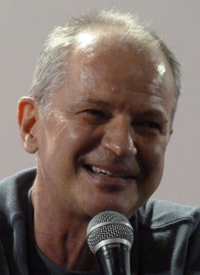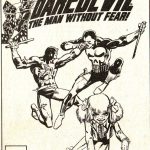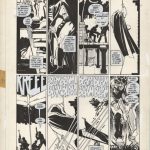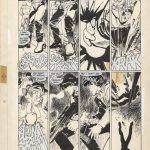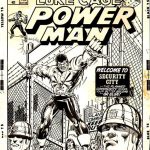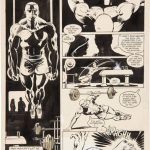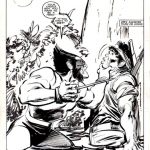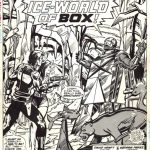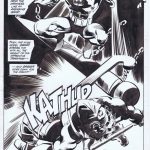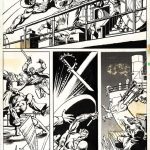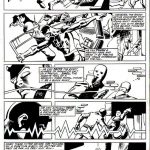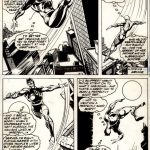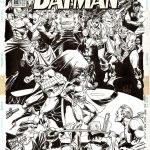“Klaus Janson was my teacher at The School of Visual Arts from the fall of 1992 to the spring of 1993. I owe much of what I know about inking and illustration to him, and on a personal level nobody could have been a better mentor. He took a personal interest in me and my work, and away from school, he helped me create the portfolio that landed me my first professional work in the summer of 1993. Stylistically, nobody compares to Klaus, and he taught me everything I know about using line weights to achieve depth in a drawing. The influence of his bold, expressive inking style helped me form my own style, and informs my work to this day. Nearly twenty years after we met, I know I can always count on his support, both personally and professionally. Klaus is most certainly a Hall of Fame Artist, but even more important, he is a generous person, a giving mentor, and a great friend.” — Rich Faber, 2/23/2011
Klaus Janson was one of Marvel’s original ‘superstar’ artists, along with Terry Austin and Tom Palmer and he built this reputation on the back of his totally unique work over the pencils of Gene Colan, Rich Buckler and, most famously, Frank Miller. Just when his reputation as an inker extraordinaire appeared to be set, Klaus decided that he wanted to develop and become an all round artist, branching out into pencilling and colouring. But the road was not always paved with gold for Klaus.
Klaus came to America from Germany, and, like a lot of immigrants, from Kiss bassist Gene Simmons through to Klaus himself, he learnt to read English via the medium of comic books. A healthy interest soon became the chosen path, cemented permanently with a postcard from none other than Stan ‘The Man’ Lee.
“I knew when I was about six or seven that this was what I wanted to do,” said Klaus in an interview done in the late 1980s. “I think what clinched it for me was that I got a postcard in response to a letter I sent to Marvel Comics. It was after Spider-Man #6 came out, the first time the Lizard appeared. I was so knocked out by Steve Ditko’s work and by the story that I sent a fan letter. I got a postcard back from Stan the Man with his signature written in pen and everything! I was so shocked. It was such a thrill for me, and I think that kind of clinched it. I wanted to be part of that. At that time I decided that’s what I was going to do, and started drawing and making up stories and the like.”
Once Klaus left school a chance meeting with Dick Giordano led to Klaus being taken on as an assistant, where he learnt the craft of inking. Klaus moved to New York soon after and working with Giordano, he inked the backgrounds on most of the jobs that came Dick’s way, including Frank Brunner’s Dr Strange. Despite his growing skills, he soon got used to rejection and would recount those days with a certain degree of cheer. “I used to sit out in Bryant Park, which is now a drug park on 42nd Street, “says Klaus, “and I’d look over the Xeroxes of the Gil Kane or Sal Buscema samples they gave me so I could ink them over vellum. I would get home and it would be like eight o’clock at night, and I would eat dinner and work for a couple of hours, and then work the next day. Then I’d come in the day after with the finished samples and be rejected! Then I’d go back to Bryant Park looking at the new samples that they gave me.” During Klaus’s visits to Marvel he soon became acquainted with Mike Esposito and Frank Giacoia, both of whom used his skills as an assistant/background inker. Further work for Klaus would come in the form of adding Zip-A-Tone onto stats of art destined for reprinting in the UK at the behest of Sol Brodsky, work that Klaus recalled as being ‘awful’. During this time he kept adding to his portfolio and producing work for fanzines.
Fate would soon inject itself into Klaus’s career in the form of Rich Buckler. Buckler, at the time, was beginning to work on Black Panther in the pages of Jungle Action and needed an inker. As Rich stated in 2010, “My choice from the start was a young prodigy of Dick Giordano’s named Klaus Janson. This was to be Klaus big break and his first solo inking for Marvel. I liked Klaus from the beginning (hey, what’s not to like?), and I remember his favorite expression which he used often was ‘Oh, give me a break’. He too was totally immersed in his work and totally dedicated, and he was ready to do professional work. There was one problem, though. Nobody who was hiring was taking him seriously (remember that old Catch 22?).
“I had handed in the first half of Jungle Action #6 and still no word from the ‘powers that be.’ I decided to take matters into my own hands – literally – and snatched the pages back when production manager John Verpoorten was looking the other way. Big John saw me walking away with the pages in tow and yelled ‘Rich! Where do you think you’re going with those pages?’ I yelled out loud, without looking back, ‘Klaus is going to ink them!’ And he yelled back ‘No he’s not!’ I said “Yes he is!” And I kept walking.”
Realising that this was going to be the break that he’d been looking for, Klaus took his chances and went all out, producing some of his best work and showing the comic book world that he had indeed learnt his lessons well. The finished result showed the subtleties of Buckler’s art and brought out a sense of dynamism like no inker had done before. When Buckler began work on his own creation, Deathlok, Janson was his inker of choice.
Klaus began to ink other pencilers from then onwards, growing both in quality and stature with each run that he did. Eventually he was paired with Gene Colan for an extended run on Daredevil, a character which is now synonymous with both men. It was while working on Daredevil that Klaus found himself inking artists as diverse as Gil Kane, Carmine Infantino, Sal Buscema and Bob Brown; however his unique style of inking gave the book a sense of cohesion and continuity throughout. When Colan left the book, after issue #157, Klaus was retained and paired with a young up and coming penciler, with whom he established an instant rapport: Frank Miller.
Many words have been said about the Miller-Janson collaboration, which lasted from 1979 through to 1988. Janson remains the best inker that Miller ever had, and Miller remains the most sympathetic penciler that Janson ever worked with. The fact that people still admire, and desire, their artwork over thirty years later is testament to the quality of their output and both their Daredevil and later Batman work has never been out of print since. In Janson, Miller found an inker who would allow him to develop and grow, to explore and experiment and in Miller Klaus found a penciler and storyteller who would encourage him to do the same. The partnership was always fated to be a relatively short one, but it was an extremely powerful one. Klaus’s contribution to the partnership is one that should never be understated, as he himself stated shortly after, “I feel that I’ve been overlooked on my contributions to Daredevil. People always talk about how moody it was, that it was a ‘film noir’ comic book and all these things. That was my contribution to the book; that was not as much Frank’s doing as it was my doing. The gutsy feeling, a lot of the shadows, a lot of the blacks, a lot of the mood of Daredevil was mine.”
Moving from Marvel to DC Klaus found himself again working with Frank Miller on the legendary Batman: The Dark Knight Returns. Sadly the two men would have a falling out during this time and would never work together again. “Frank and I had a complete falling out on Dark Knight,” said Janson at the time, “We’re not going to work together any more; the falling out was that extensive, Frank was not happy with the inking job that I did on the third book. By my own admission, it’s not the best job I’ve ever done, but it also wasn’t the worst thing I’ve ever done. He wanted me to quit. But I wouldn’t quit because I didn‘t think that I had any reason to quit. My feeling was that I wouldn’t quit, but if somebody were to fire me I would accept that. In a nutshell, cooler heads prevailed and I inked the fourth book.”
By this stage Klaus had expanded into being an all round artist, pencilling, inking and colouring his own work. “If I were to continue inking solely, “says Klaus, “I could continue to ink two books a month. I’m more interested in pencilling, which requires more hidden time. It’s hidden in terms of the fact that there’s more things to do that the reader doesn’t necessarily see.” Klaus had approached DC with the idea of doing short stories that he would then draw and colour, and DC obliged by assigning him Batman stories. Despite the shift in priorities, Klaus would steadfastly defend his role as an inker. “I think that inkers in general get the shaft,” stated Klaus, “I always approach my inking work as a creative act. I think Neal Adams has been quoted as saying that inkers were basically tracers – if Neal didn’t say that, I apologize – but I never approached my work as a tracer. I always approach my work creatively. I don’t do anything differently when I sit down to pencil. I have the same attitude, same approach, same goals. Yet inking is considered “less” somehow compared to pencilling. Inkers don’t, generally, get enough credit. I don’t know what to do about it. I don’t know if there‘s anything to do about it.”
This sense of pride and quality also spills over into Klaus’s view on colouring. “I don’t think of coloring as less ‘art’ than inking or pencilling or writing.” Klaus states, “I think it’s just as important. A lot of times a good pencilling job or a good inking job can, be mined to hell by a bad coloring job. So l figure if they’re ruining my stuff, let me take a crack at it. I can ruin my stuff just as well as anybody else can so let me do it! I enjoy following the concept all the way through from the pencilling stage to the final colored product.”
Klaus Janson was one of the original ‘superstar’ inkers and has remained that way. The quality of his work has never deteriorated, be it pencils, inks or colours, and his impact has been felt upon inkers for an entire generation and beyond. Klaus remains in demand, both as an artist and as an educator at the School of Visual Arts in New York City, (where he has spent over a decade teaching artists how to draw). His more recent collaborations with John Romita Jr on The Punisher, Wolverine and Spider-Man have seen him remain firmly in the spotlight, and in demand as much today as he ever was. “I remember running into Klaus at the Marvel offices in the ’90s,” recalled Bob Almond, “I don’t recall the exact year to know what I was working on but he was turning in pages he inked over Erik Larsen for the Defenders series at that time. I expressed to him how much I adored his work and how he was a big influence on me…we joked about how I was fond of his Daredevil work years before that Miller guy. And I informed him about how Scott Williams named him as his major influence since Scott tried to simulate Klaus’ extreme line weights….so as different as their styles were, we laughed about him being the Father of the Image Quill-Exclusive Style of Inking. He took it all in a self-deprecating manner. A cool, pleasant, and professional artist, I’ve always enjoyed my occasional correspondences with him over the years.” Joe Rubinstein agrees. “Klaus is a thinking man’s inker,” says Joe, “who always looks to stretch his considerable artistic muscles. The work is always bold, exciting, innovating and sensitive to the intention of the work. Not only are all his jobs interesting to look at but you never know what surprise you’ll get from page to page.”
“Klaus was definitely a favorite artist of mine,” said Greg LaRoque, “and always on my list of those I hoped to work with.” “Klaus is a true original,” continues Bob Almond. “ You look at his work and not only does his line look different than anyone else, including his teacher Dick Giordano, but he constantly breaks all of the inking ‘rules’ that other ink artists follow, and it works for him and always has….not an easy task.” With such success it’d be understandable if Klaus decided to just sit back and cruise, but he has never been one to stagnate. “I’m always interested in stretching,” Klaus says, “in trying something different. I’m goal conscious. I’m aware of the next thing or the next challenge. I am aware of what I want to be doing next. I think that I overcompensate for what I perceive to be flaws or deficiencies in the work by trying extra hard. I can say that without uh-well, it’s an honest statement. It‘s part of my pathology. I always do try. I remember when I was a kid, going to the mom-and-pop store and buying comics. I was really thrilled at the work that people were doing. I got involved with Wally Wood’s magazine, Witzend, through the mail, and that was a real breakthrough. It was my first fanzine and it had great art. It was a real thrill. I don’t know why, but I think in some ways that if I try extra hard that I could give somebody else a thrill. That’s my motive for always giving or at least trying to.”
Daniel Best

